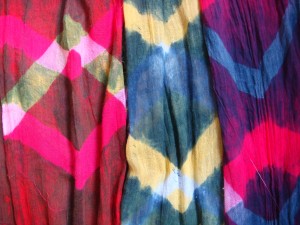
Photo by Barbara Shapiro
In many parts of the greater Bay Area it is way too hot in the summer to wear a silk scarf, but we do love a bit of color around the neck. Why not make a feather light gauzy cotton scarf dyed laharia style. There was a great article on this technique by Carol Westfall in the Spring 2004 issue of Shuttle Spindle and Dyepot which is my reference for how to produce a lovely multi colored accessory. The internet provides many images of traditional pieces. Laharia comes from the Sanskrit word for wave and the patterns achieved by master Indian dyers do evoke rolling waters. Traditionally the long lengths of this colorful sheer cotton cloth were wound into beautiful turbans popular during the 19th Century in Rajasthan, India.
I like to use the Bubble Cotton gauze from Dharma. (at Dharma Trading .com). You can purchase a 2 yard length and get several scarves from it. Current fashion trends allow you to skip the hemming my grandmother would have insisted on.
Cut a scarf length piece about 6 to 8 inches wide and as long as you like. Fold it in half or thirds lengthwise and wet the fabric thoroughly. Squeeze out the extra water and flatten it out still folded. Pull strongly on one corner while your partner holds the opposite corner. You may also use a C clamp to hold one corner to a table top while you pull on the opposite corner. Pull strongly on the diagonal stretching on the bias of the cloth. Then twist the scarf up until you cannot twist any more without it curling back on itself. Maintain the tension and the diagonal pull all the time. Fasten the free end to another piece of furniture so that the bundle is stretched out straight and doesn’t untwist. Begin wrapping sections of the twisted cloth with string (or ikat tape) just as you would a normal ikat warp bundle. I like to use ordinary kitchen string for this as it goes pretty fast even if your wraps are close together. Be sure not to let the twist or diagonal pull come out. I suggest leaving 4 to 6 inches between wrapped areas which can be 2 to 4 inches long, but you may do much smaller wraps or wraps of varied sizes. The wrapping should be tight enough to prevent dye from penetrating. Release the tension from the C clamps. Soak again and then dye this bound piece of cloth in Procion, natural dyes or indigo, whatever you normally use for cotton. The unbound areas will unwind in the dye bath and that’s fine. Rinse then unwrap and wash the whole cloth. Refold the cloth and pull on the opposite diagonal to create crossing colors of dye. Be sure to wrap up some of the first dyed area to preserve it and allow some to get over dyed by the next color. You may apply different colors of liquid dye in different areas between the various wraps using a squeeze bottle instead of using a second dye bath. Steam or set the dye as you normally do. After a final rinse you should have a colorful bit of lightweight cotton to perk up a summer outfit.
You can try this technique with a very sheer narrow silk scarf blank, as well, using acid dyes, but avoid any cloth that is too dense. It is the sheerness of the cloth that allows full penetration of the dyes. Enjoy!
Sample scarves were dyed by students in my recent SAQA/SDA workshop.
More thoughts on Summer next.